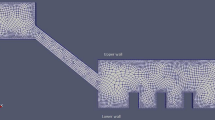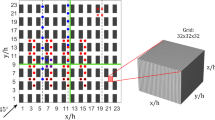Abstract
A new atmospheric micro-scale chemistry, transport and stream model, MITRAS, has been developed within the Tropospheric Research Program (TFS). MITRAS is an obstacle resolving model solving simultaneously the governing equations for chemistry, pollutant transport including soot as well as for the flow and temperature field. The chemical reaction module is based on a simplified RACM mechanism. MITRAS has been tested against quality ensured wind tunnel data. The model results on soot and ozone concentrations as well as on the spatial representativeness of measurement sites underline the necessity for high-resolution flow simulations for case studies on close-to-source chemistry and pollutant transport within the urban canopy layer.
Similar content being viewed by others
References
ASCE, 1987: Manual of practice for wind tunnel studies of buildings and structures, American Society of Civil Engineers, Aerospace Division.
Blinda, S., Hopf, A., and Marnier, G., 1994: Numerical simulation of wind fields and dispersion of gaseous pollutants in built-up areas, Meteorol. Zeitschrift NF3, 198-201.
Deardorff, J. W., 1978: Efficient prediction of ground surface temperature and moisture, with inclusion of a layer of vegetation, J. Geophys. Res. 83, 1889-1903.
Eichhorn, E., 1989: Entwicklung und Anwendung eines dreidimensionalen mikroskaligen Stadtklima-Modells, Dissertation, Fachbereich Physik, Universität Mainz, Germany.
ESDU, 1985: Characteristics of Atmospheric Turbulence near the Ground. Part II: Single Point Data for Strong Winds (Neutral Atmosphere), Engineering Sciences Data Unit, Item No. 85020, London, U.K.
Garbrecht, T., Lüpkes, C., Augstein, E., and Wamser, C., 1999: Influence of a sea ice ridge on low level airflow, J. Geophys. Res. 104 D20, 24499-24507.
Gross, G., 1997: ASMUS - Ein numerisches Modell zur Berechnung der Strömung und der Schadstoffverteilung im Bereich einzelner Gebäude, II: Schadstoffausbreitung und Anwendung, Meteorol. Zeitschrift NF6, 130-136.
Hindmarsh, A. C., 1983: ODEPACK, A systematized collection of ODE solvers, in R. S. Steplman et al.(eds), Scientific Computing, North-Holland, Amsterdam, The Netherlands, pp. 55-74.
Hundsdorfer, W., Coren, B., van Loon, M., and Verwer, J. G., 1995: A positive finite-difference advection scheme, J. Comp. Phys. 117, 35-46.
Kapitza, H. and Eppel, D., 1987: A 3-D poisson solver based on conjugate gradients compared to standard iterative methods and its performance on vector computers, J. Comp. Phys. 68, 474-484.
Kato, M. and Launder, B. E., 1993: The modeling of turbulent flow around stationary and vibrating square cylinders, 9th Symposium on turbulent shear flows, Kyoto, 10-4-1-10-4-6.
Ketzel, M., Berkowicz, R., and Lohmeyer, A., 2000: Comparison of numerical street dispersion models with results from wind tunnel and field measurements, Environ. Monitor. Assess. 65, 363-370.
Kim, J.-J. and Baik, J.-J., 1999: A numerical study of thermal effects on flow and pollutant dispersion in urban street canyons, J. Appl. Met. 38, 1249-1261.
Knoth, O. and Wolke, R., 1998: An explicit-implicit numerical approach for atmospheric chemistrytransport modelling, Atmos. Environ. 32, 1785-1797.
Lakehal, D., Mestayer, P. G., Edson, J. B., Anquetin, S., and Sini, J.-F., 1995: Eulero-Lagrangian simulation of raindrop trajectories and impact within the urban canopy, Atmos. Environ. 29, 3501-3517.
Lary, D. J., Lee, A. M., Toumi, R., Newchurch, M. J., Pirre, M., and Renard, J. B., 1997: Carbon aerosols and atmospheric photochemistry, J. Geophys. Res. 102, 3671-3682.
Leitl, B. and Schatzmann, M., 1999: Generation of high resolution reference data for validation of micro-scale dispersion models, in VDI-KRdL Recent Developments in Measurement and Assessment of Air Pollution, VDI-Berichte 1443, VDI-Verlag, ISBN 3-18-091443-2, pp. 647-656.
López, S. D., 2002: Numerische Modellierung turbulenter Umströmungen von Gebäuden, Reports on Polar and Marine Research, 418, Alfred Wegener Institute for Polar and Marine Research Bremerhaven, Germany, ISSN 1618-3193, p. 93.
Louka, P., Vacon, G., Sini, J.-F., Mestayer, P. G., and Rosant, J.-M., 2001: Thermal effects on the airflow in a street canyon - Nantes’ 99 experimental results and model simulation, Third International Conference on Urban Air Quality and Fifth SATURN Workshop, 19-23.03.2001, Loutraki, Greece.
Panskus, H., 2000: Konzept zur Evaluation hindernisauflösender mikroskaliger Modelle und seine Anwendung auf das Modell MITRAS, Fortschritt-Berichte VDI, VDI-Verlag, Düsseldorf, Germany, ISBN 3-18-338907-X 7-389, p. 97.
Schlünzen, K. H., 1990: Numerical studies on the inland penetration of sea breeze fronts at a coastline with tidally flooded mudflats, Beitr. Phys. Atmosph. 63, 243-256.
Schlünzen, K. H. and Pahl, S., 1992: Modification of dry deposition in a developing sea-breeze circulation - a numerical case study, Atmos. Environ. 26A, 51-61.
Shapiro, C., 1971: The use of linear filtering as a parameterization of diffusion, J. Atmos. Sci. 28, 523-531.
Sievers, U., 1995: Verallgemeinerung der Stromfunktionsmethode auf drei Dimensionen, Meteorol. Zeitschrift NF4, 3-15.
Simiu, E. and Scanlan, R. H., 1986: Wind Effects on Structures - Part A: The Atmosphere, Wiley and Sons Inc., ISBN 0-471-86613-X.
Sini, J.-F., Anquetin, S., and Mestayer, P. G., 1996: Pollutant dispersion and thermal effects in urban street canyons, Atmos. Environ. 30, 2659-2677.
Stockwell, W. R., Kirchner, F., Kuhn, M., and Seefeld, S., 1997: A new mechanism for regional atmospheric chemistry modeling, J. Geophys. Res. 102, 25847-25879.
Uehara, K., Murakami, S., Oikawa, S., and Wakamatsu, S., 2000: Wind tunnel experiments on how thermal stratification affects flow in and above urban street canyons, Atmos. Environ. 34, 1553-1562.
Wilck, M. and Stratmann, F., 1996: A lognormal model for the size-resolved treatment of particle dynamics and liquid phase chemistry, J. Aerosol Sci. 27, 583-584.
Winkler, Ch., 1995: Mathemathische Modellierung der quellnahen Ausbreitung von Emissionen, Fortschrittsberichte VDI, 7–268.
Wolke, R. and Knoth, O., 2000: Implicit-explicit Runge-Kutta methods applied to atmospheric chemistry-transport modelling, Environ. Model. Software 15, 711-719.
Yamartino, R. and Wiegand, G., 1986: Development and evaluation of simple models for the flow, turbulence and pollutant concentration fields within an urban street canyon, Atmos. Environ. 20, 2137-2156.
Author information
Authors and Affiliations
Rights and permissions
About this article
Cite this article
Schlünzen, K.H., Hinneburg, D., Knoth, O. et al. Flow and Transport in the Obstacle Layer: First Results of the Micro-Scale Model MITRAS. Journal of Atmospheric Chemistry 44, 113–130 (2003). https://doi.org/10.1023/A:1022420130032
Issue Date:
DOI: https://doi.org/10.1023/A:1022420130032




